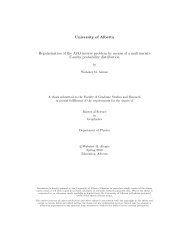Soner Bekleric Title of Thesis: Nonlinear Prediction via Volterra Ser
Soner Bekleric Title of Thesis: Nonlinear Prediction via Volterra Ser
Soner Bekleric Title of Thesis: Nonlinear Prediction via Volterra Ser
You also want an ePaper? Increase the reach of your titles
YUMPU automatically turns print PDFs into web optimized ePapers that Google loves.
2.3. LINEAR PREDICTION 16<br />
∂ρ fb<br />
p<br />
∂Rekp<br />
+ i ∂ρfb p<br />
∂Imkp<br />
= 0 (2.25)<br />
where Re and Im are real and imaginary parts, respectively, <strong>of</strong> the complex deriva-<br />
tive. A least squares solution ensures a solution for prediction coefficients, kp as<br />
follows:<br />
kp =<br />
where ∗ is the complex conjugation.<br />
−2 N n=p+1 ε f<br />
p−1(n)εb∗ p−1(n − 1)<br />
Nn=p+1 |ε f<br />
p−1(n)| 2 + N n=p+1 |εb p−1(n − 1)| 2<br />
(2.26)<br />
2.3.4 Computing the AR coefficients without limiting the<br />
aperture<br />
The Yule-Walker and Burg algorithms are <strong>of</strong>ten used in signal processing algorithms<br />
for their computational efficiency at the time <strong>of</strong> computing prediction error coeffi-<br />
cients. In what follows I will provide a method that I have introduced in order to<br />
solve for the coefficients <strong>of</strong> the linear prediction problem using only the data that<br />
are available. In other words, I will avoid creation <strong>of</strong> the correlation matrix and<br />
directly posed the problem as a least-squares problem.<br />
Consider a filter length p = 3 and a time series <strong>of</strong> length N = 7. Using equations<br />
(2.12) and (2.13) I can write the following equations:









